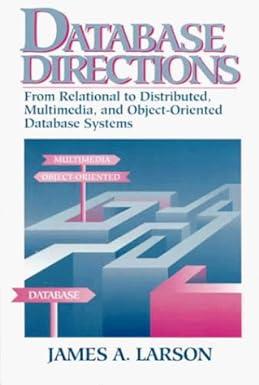Answered step by step
Verified Expert Solution
Question
1 Approved Answer
This is the entire question, this is all the data Sleepless Nights? (continued) EXPLORATION 3.3 Recall Exploration 2.2 where you investigated whether, on average, students
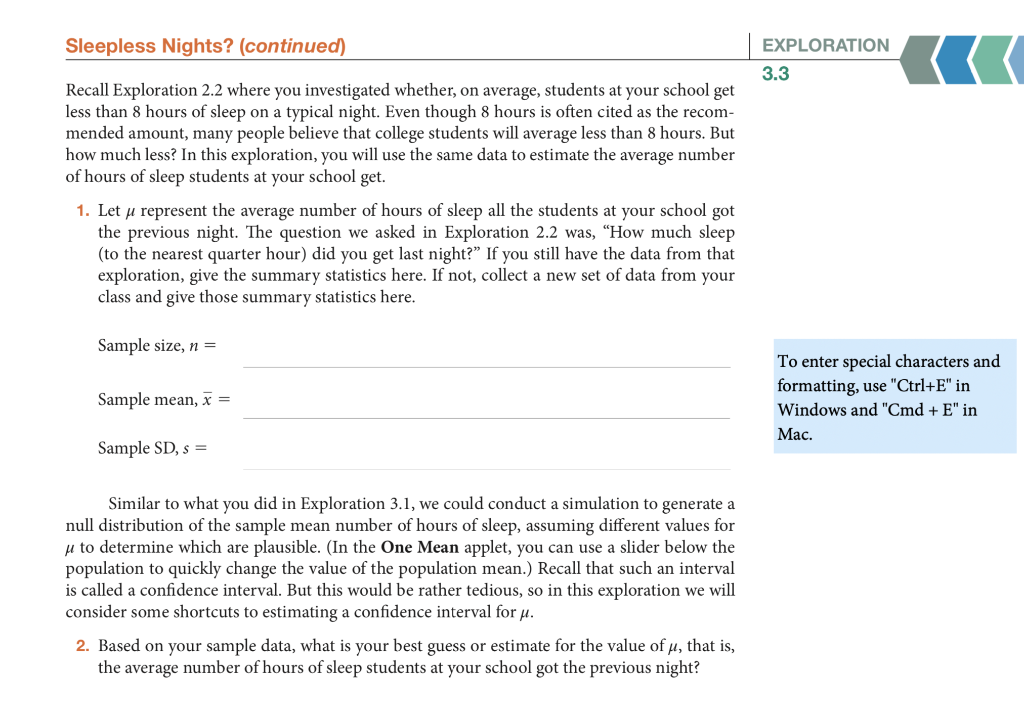
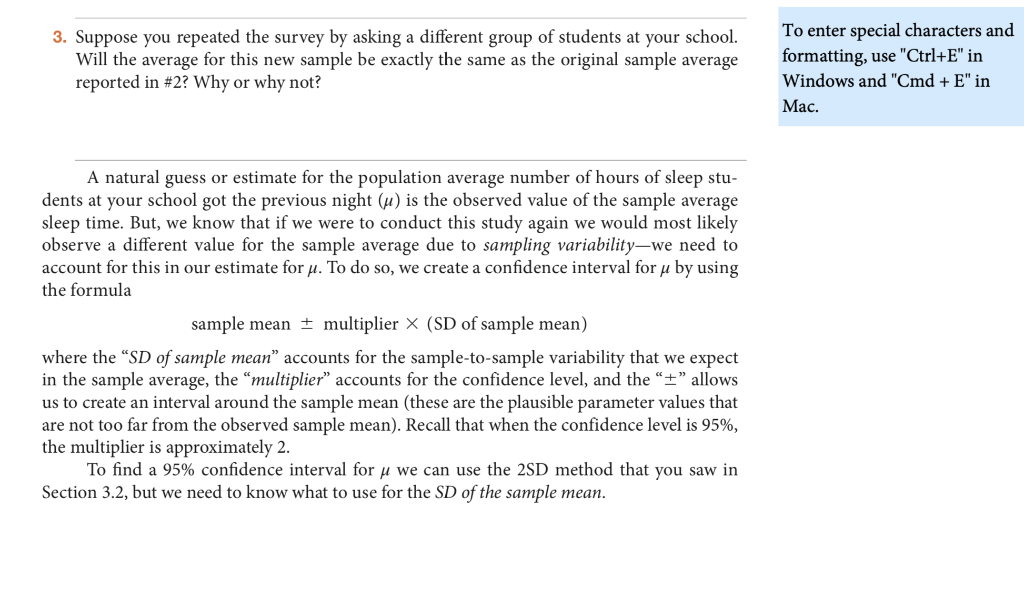
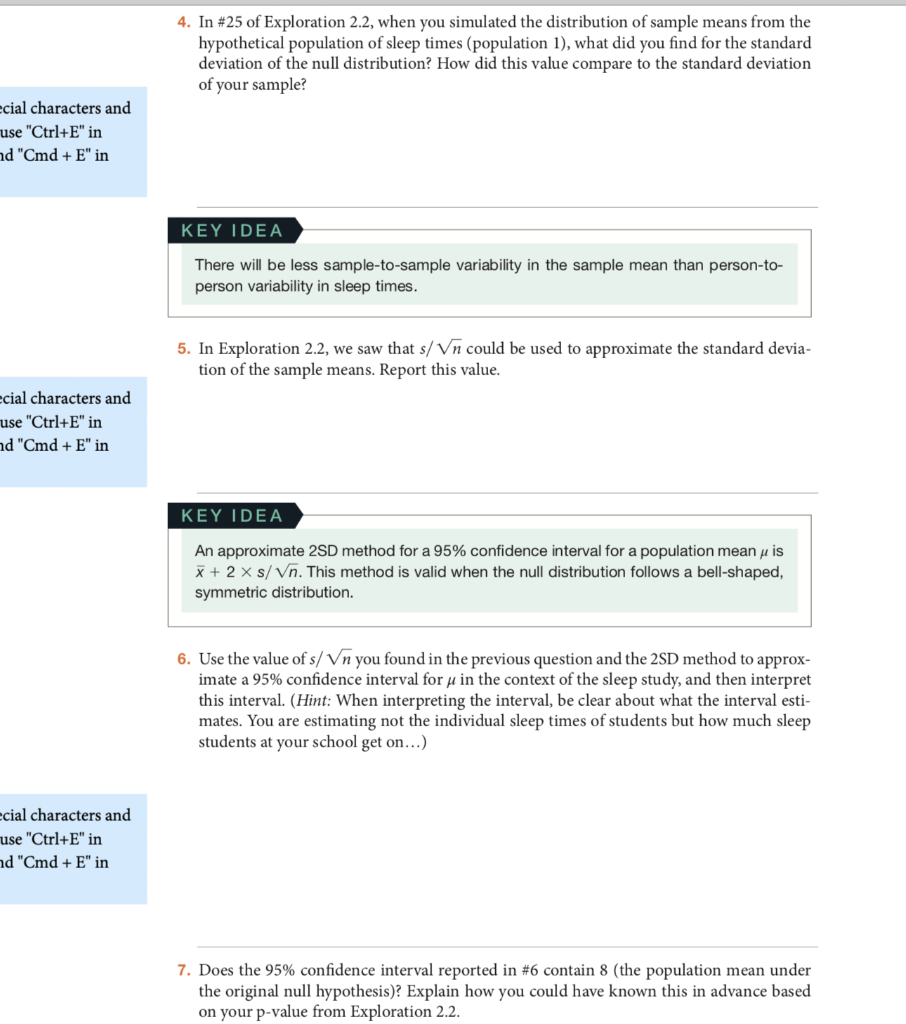
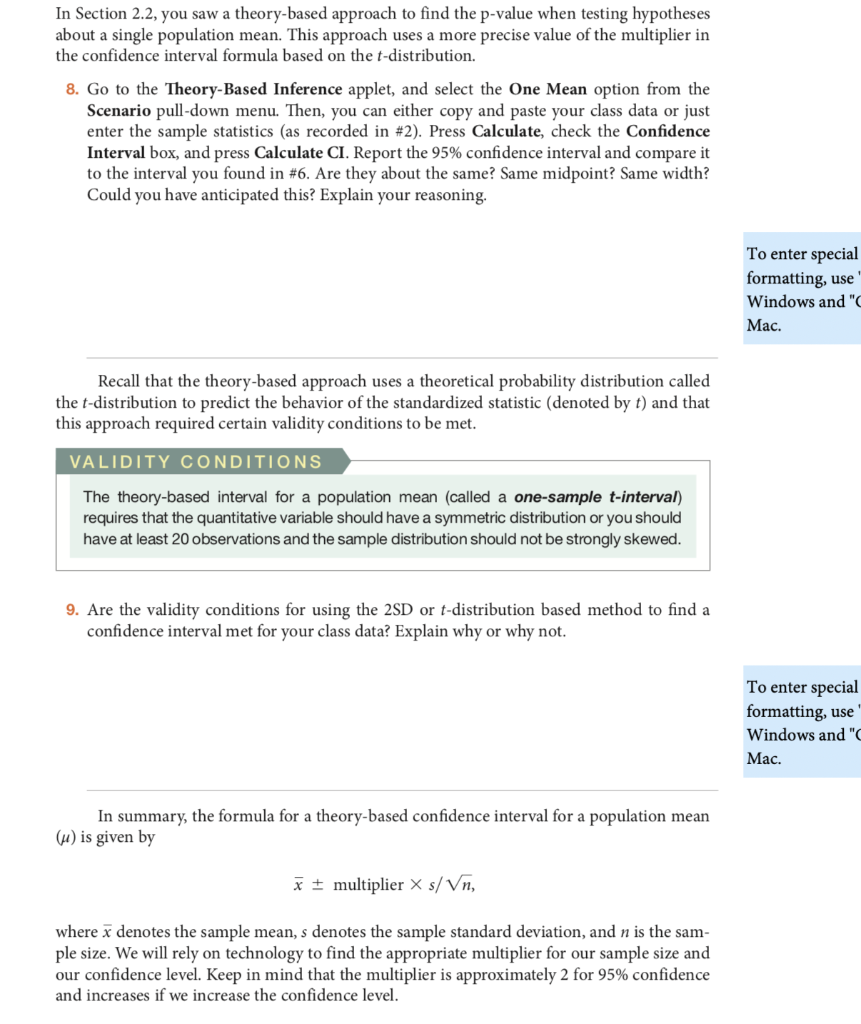
This is the entire question, this is all the data
Sleepless Nights? (continued) EXPLORATION 3.3 Recall Exploration 2.2 where you investigated whether, on average, students at your school get less than 8 hours of sleep on a typical night. Even though 8 hours is often cited as the recom mended amount, many people believe that college students will average less than 8 hours. But how much less? In this exploration, you will use the same data to estimate the average number of hours of sleep students at your school get. 1. Let u represent the average number of hours of sleep all the students at your school got the previous night. The question we asked in Exploration 2.2 was, "How much sleep (to the nearest quarter hour) did you get last night?" If you still have the data from that exploration, give the summary statistics here. If not, collect a new set of data from your class and give those summary statistics here Sample size, n - To enter special characters and formatting, use "Ctrl+E" in Windows and "Cmd +E" in Mac. Sample mean, x Sample SD,s Similar to what you did in Exploration 3.1, we could conduct a simulation to generate a null distribution of the sample mean number of hours of sleep, assuming different values for u to determine which are plausible. (In the One Mean applet, you can use a slider below the population to quickly change the value of the population mean.) Recall that such an interval is called a confidence interval. But this would be rather tedious, so in this exploration we will consider some shortcuts to estimating a confidence interval for p 2. Based on your sample data, what is your best guess or estimate for the value of u, that is, the average number of hours of sleep students at your school got the previous night? 3. Suppose you repeated the survey by asking a different group of students at your school. To enter special characters and Will the average for this new sample be exactly the same as the original sample average reported in #2? Why or why not? formatting, use "Ctrl+E" in Windows and "Cmd + E" in Mac. A natural guess or estimate for the population average number of hours of sleep stu- dents at your school got the previous night (u) is the observed value of the sample average sleep time. But, we know that if we were to conduct this study again we would most likely observe a different value for the sample average due to sampling variability-we need to account for this in our estimate for . To do so, we create a confidence interval for by using the formula sample mean multiplier X (SD of sample mean) where the "SD of sample mean" accounts for the sample-to-sample variability that we expect in the sample average, the "multiplier" accounts for the confidence level, and the "+" allows us to create an interval around the sample mean (these are the plausible parameter values that are not too far from the observed sample mean). Recall that when the confidence level is 95%, the multiplier is approximately 2. To find a 95% confidence interval for we can use the 2SD method that you saw in Section 3.2, but we need to know what to use for the SD of the sample mean. 4. In #25 of Exploration 2.2, when you simulated the distribution of sample means from the hypothetical population of sleep times (population 1), what did you find for the standard deviation of the null distribution? How did this value compare to the standard deviation of your sample? cial characters and use "Ctrl+E" in d "Cmd +E" in KEY IDEA There will be less sample-to-sample variability in the sample mean than person-to- person variability in sleep times 5. In Exploration 2.2, we saw that s/Vn could be used to approximate the standard devia- tion of the sample means, Report this value cial characters and use "Ctrl+E" in d "Cmd E" in KEY IDEA An approximate 2SD method for a 95% confidence interval for a population mean is x + 2 X s/Vn. This method is valid when the null distribution follows a bell-shaped symmetric distribution. 6. Use the value of s/Vn you found in the previous question and the 2SD method to approx- imate a 95% confidence interval for in the context of the sleep study, and then interpret this interval. (Hint: When interpreting the interval, be clear about what the interval esti mates. You are estimating not the individual sleep times of students but how much sleep students at your school get on...) cial characters and use "Ctrl+E" in d "Cmd +E" in 7. Does the 95% confidence interval reported in #6 contain 8 (the population mean under the original null hypothesis)? Explain how you could have known this in advance based on your p-value from Exploration 2.2 In Section 2.2, you saw a theory-based approach to find the p-value when testing hypotheses about a single population mean. This approach uses a more precise value of the multiplier in the confidence interval formula based on the t-distribution 8. Go to the Theory-Based Inference applet, and select the One Mean option from the Scenario pull-down menu. Then, you can either copy and paste your class data or just enter the sample statistics (as recorded in #2). Press Calculate, check the Confidence Interval box, and press Calculate CI. Report the 95% confidence interval and compare it to the interval you found in #6. Are they about the same? Same midpoint? Same width? Could you have anticipated this? Explain your reasoning. To enter special formatting, use Windows and" Recall that the theory-based approach uses a theoretical probability distribution called the t-distribution to predict the behavior of the standardized statistic (denoted by t) and that this approach required certain validity conditions to be met VALIDITY CONDITIONS The theory-based interval for a population mean (called a one-sample t-interval) requires that the quantitative variable should have a symmetric distribution or you should have at least 20 observations and the sample distribution should not be strongly skewed 9. Are the validity conditions for using the 2SD or t-distribution based method to find a confidence interval met for your class data? Explain why or why not To enter special formatting, use Windows and" Mac. In summary, the formula for a theory-based confidence interval for a population mearn (u) is giver x + multiplier x s/Vn, where x denotes the sample mean, s denotes the sample standard deviation, and n is the sam ple size. We will rely on technology to find the appropriate multiplier for our sample size and our confidence level. Keep in mind that the multiplier is approximately 2 for 95% confidence and increases if we increase the confidence level Sleepless Nights? (continued) EXPLORATION 3.3 Recall Exploration 2.2 where you investigated whether, on average, students at your school get less than 8 hours of sleep on a typical night. Even though 8 hours is often cited as the recom mended amount, many people believe that college students will average less than 8 hours. But how much less? In this exploration, you will use the same data to estimate the average number of hours of sleep students at your school get. 1. Let u represent the average number of hours of sleep all the students at your school got the previous night. The question we asked in Exploration 2.2 was, "How much sleep (to the nearest quarter hour) did you get last night?" If you still have the data from that exploration, give the summary statistics here. If not, collect a new set of data from your class and give those summary statistics here Sample size, n - To enter special characters and formatting, use "Ctrl+E" in Windows and "Cmd +E" in Mac. Sample mean, x Sample SD,s Similar to what you did in Exploration 3.1, we could conduct a simulation to generate a null distribution of the sample mean number of hours of sleep, assuming different values for u to determine which are plausible. (In the One Mean applet, you can use a slider below the population to quickly change the value of the population mean.) Recall that such an interval is called a confidence interval. But this would be rather tedious, so in this exploration we will consider some shortcuts to estimating a confidence interval for p 2. Based on your sample data, what is your best guess or estimate for the value of u, that is, the average number of hours of sleep students at your school got the previous night? 3. Suppose you repeated the survey by asking a different group of students at your school. To enter special characters and Will the average for this new sample be exactly the same as the original sample average reported in #2? Why or why not? formatting, use "Ctrl+E" in Windows and "Cmd + E" in Mac. A natural guess or estimate for the population average number of hours of sleep stu- dents at your school got the previous night (u) is the observed value of the sample average sleep time. But, we know that if we were to conduct this study again we would most likely observe a different value for the sample average due to sampling variability-we need to account for this in our estimate for . To do so, we create a confidence interval for by using the formula sample mean multiplier X (SD of sample mean) where the "SD of sample mean" accounts for the sample-to-sample variability that we expect in the sample average, the "multiplier" accounts for the confidence level, and the "+" allows us to create an interval around the sample mean (these are the plausible parameter values that are not too far from the observed sample mean). Recall that when the confidence level is 95%, the multiplier is approximately 2. To find a 95% confidence interval for we can use the 2SD method that you saw in Section 3.2, but we need to know what to use for the SD of the sample mean. 4. In #25 of Exploration 2.2, when you simulated the distribution of sample means from the hypothetical population of sleep times (population 1), what did you find for the standard deviation of the null distribution? How did this value compare to the standard deviation of your sample? cial characters and use "Ctrl+E" in d "Cmd +E" in KEY IDEA There will be less sample-to-sample variability in the sample mean than person-to- person variability in sleep times 5. In Exploration 2.2, we saw that s/Vn could be used to approximate the standard devia- tion of the sample means, Report this value cial characters and use "Ctrl+E" in d "Cmd E" in KEY IDEA An approximate 2SD method for a 95% confidence interval for a population mean is x + 2 X s/Vn. This method is valid when the null distribution follows a bell-shaped symmetric distribution. 6. Use the value of s/Vn you found in the previous question and the 2SD method to approx- imate a 95% confidence interval for in the context of the sleep study, and then interpret this interval. (Hint: When interpreting the interval, be clear about what the interval esti mates. You are estimating not the individual sleep times of students but how much sleep students at your school get on...) cial characters and use "Ctrl+E" in d "Cmd +E" in 7. Does the 95% confidence interval reported in #6 contain 8 (the population mean under the original null hypothesis)? Explain how you could have known this in advance based on your p-value from Exploration 2.2 In Section 2.2, you saw a theory-based approach to find the p-value when testing hypotheses about a single population mean. This approach uses a more precise value of the multiplier in the confidence interval formula based on the t-distribution 8. Go to the Theory-Based Inference applet, and select the One Mean option from the Scenario pull-down menu. Then, you can either copy and paste your class data or just enter the sample statistics (as recorded in #2). Press Calculate, check the Confidence Interval box, and press Calculate CI. Report the 95% confidence interval and compare it to the interval you found in #6. Are they about the same? Same midpoint? Same width? Could you have anticipated this? Explain your reasoning. To enter special formatting, use Windows and" Recall that the theory-based approach uses a theoretical probability distribution called the t-distribution to predict the behavior of the standardized statistic (denoted by t) and that this approach required certain validity conditions to be met VALIDITY CONDITIONS The theory-based interval for a population mean (called a one-sample t-interval) requires that the quantitative variable should have a symmetric distribution or you should have at least 20 observations and the sample distribution should not be strongly skewed 9. Are the validity conditions for using the 2SD or t-distribution based method to find a confidence interval met for your class data? Explain why or why not To enter special formatting, use Windows and" Mac. In summary, the formula for a theory-based confidence interval for a population mearn (u) is giver x + multiplier x s/Vn, where x denotes the sample mean, s denotes the sample standard deviation, and n is the sam ple size. We will rely on technology to find the appropriate multiplier for our sample size and our confidence level. Keep in mind that the multiplier is approximately 2 for 95% confidence and increases if we increase the confidence levelStep by Step Solution
There are 3 Steps involved in it
Step: 1

Get Instant Access to Expert-Tailored Solutions
See step-by-step solutions with expert insights and AI powered tools for academic success
Step: 2

Step: 3

Ace Your Homework with AI
Get the answers you need in no time with our AI-driven, step-by-step assistance
Get Started


